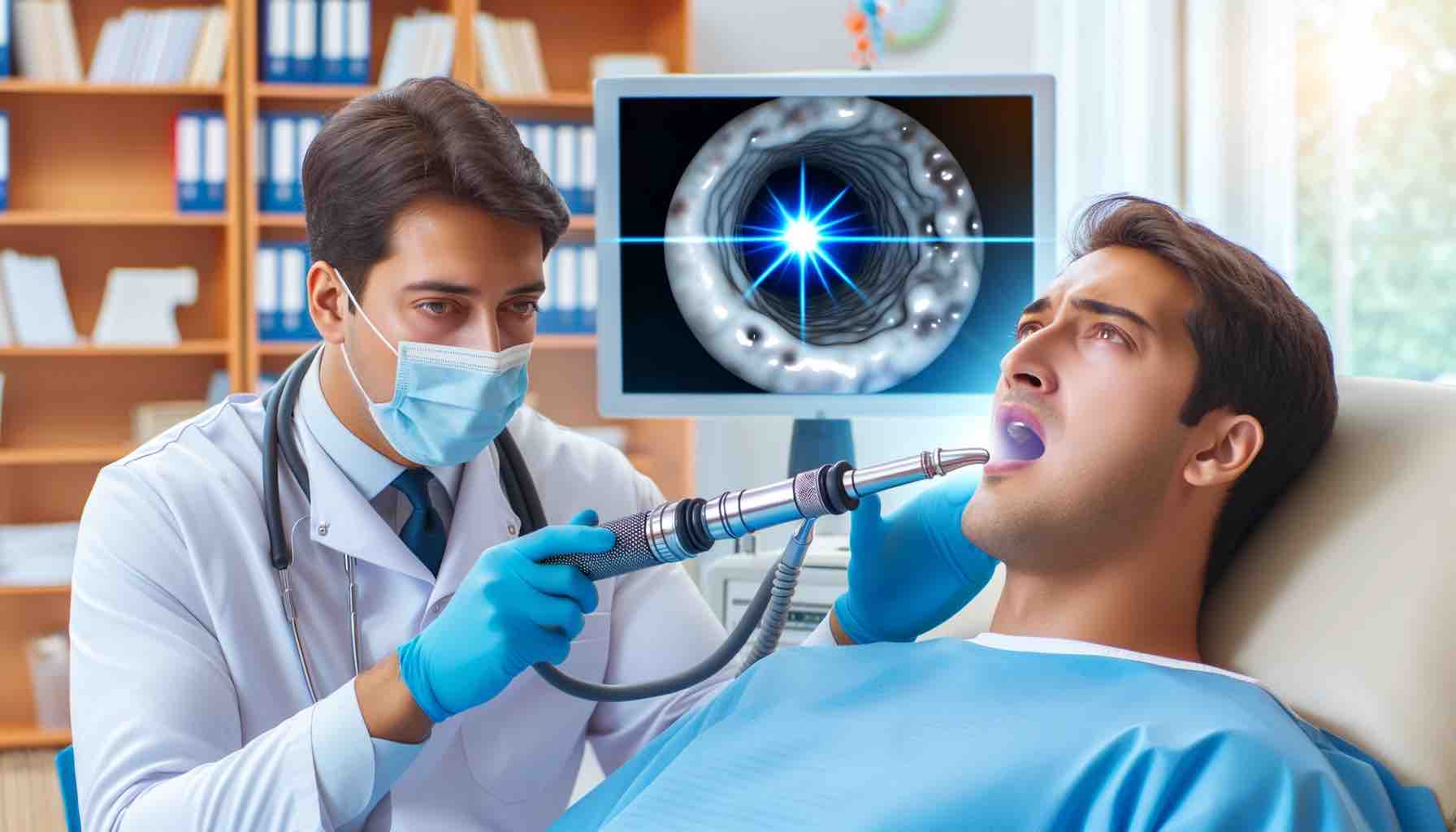
Introduction:
Eosinophilic Esophagitis (EoE) is more than just a medical term; it’s a reality for many individuals, presenting unique challenges in daily life. This condition, characterized by an influx of eosinophils in the esophagus, can significantly impact your ability to enjoy meals and maintain a healthy lifestyle. Understanding EoE is the first step toward effective management. To assist in this journey, we are thrilled to offer a comprehensive and free PDF guide focused on EoE elimination diets. This resource is designed to provide valuable insights and practical tools for those navigating the complexities of EoE.
Understanding Eosinophilic Esophagitis (EoE)
What is EoE?
EoE might sound complex, but it’s a condition that’s increasingly understood. At its core, EoE is a chronic immune/antigen-mediated condition where eosinophils, a type of white blood cell, accumulate in the esophagus. This accumulation leads to inflammation and a range of symptoms that can disrupt your normal eating habits and comfort.
Why Does Diet Matter?
One of the most effective ways to manage EoE is through dietary changes. Food can often be a trigger for EoE symptoms, and identifying which foods exacerbate your condition is a critical step in controlling it. However, navigating what to eat and what to avoid can be daunting.
The Critical Role of Dietary Management in EoE
Managing EoE effectively often involves a meticulous look at your diet. The relationship between what you eat and EoE symptoms is significant. For many, certain foods can trigger inflammation in the esophagus, leading to discomfort, pain, and difficulty swallowing.
Symptoms and Diagnosis
The symptoms of EoE can vary but often include difficulty swallowing (dysphagia), food impaction, and even chest pain. Diagnosing EoE typically involves endoscopy and biopsy, where a specialist looks for signs of eosinophilic activity in the esophagus.
Introducing the EoE Elimination Diet PDF
We understand the challenges that come with managing EoE, especially when it comes to diet. That’s why we’ve created a comprehensive EoE Elimination Diet PDF, available for free download. This guide is packed with information, from understanding EoE and its dietary implications to step-by-step instructions on managing your diet.
What’s Inside the Guide?
- Detailed Overview of EoE: A deeper look into what EoE is and how it affects your body.
- Step-by-Step Elimination Diet Instructions: Clear guidelines on how to implement and maintain an elimination diet.
- EoE-Friendly Recipes: Delicious and safe recipe ideas that cater to your dietary needs.
- Tips for Long-Term Management: Strategies to make dietary management a sustainable part of your lifestyle.
Stay tuned as we delve deeper into the specifics of various elimination diets and share practical advice for incorporating these changes into your daily life. And don’t forget to download your free copy of the EoE Elimination Diet PDF for a comprehensive guide to managing EoE through diet.
The Importance of Elimination Diets in EoE Management
Navigating Dietary Changes for EoE
For those grappling with Eosinophilic Esophagitis, the path to relief often lies in the kitchen. An elimination diet is not just a dietary change; it’s a therapeutic tool, crucial in pinpointing which foods trigger your EoE symptoms.
What is an Elimination Diet?
An elimination diet involves removing certain foods or food groups from your diet that are known to commonly trigger EoE symptoms. The goal is to eliminate these potential triggers, observe any changes in symptoms, and then gradually reintroduce these foods one at a time to identify specific triggers.
Types of Elimination Diets
- Six-Food Elimination Diet (SFED): This is the most comprehensive approach, removing the six most common allergens: dairy, wheat, eggs, soy, nuts, and seafood.
- Modified Elimination Diets: These include the two-food or four-food elimination diets, which are less restrictive and tailored based on individual sensitivities and medical advice.
Practical Steps in Implementing an Elimination Diet
Starting the Diet
- Consult a Specialist: Before embarking on this diet, consult with a healthcare professional. They can provide guidance and ensure the diet suits your specific health needs.
- Plan Your Meals: Prepare a meal plan that excludes the identified allergens. Ensure you include a variety of other foods to maintain a balanced diet.
During the Diet
- Keep a Food Diary: Document everything you eat and any symptoms you experience. This diary will be crucial when you start reintroducing foods.
- Stay Informed: Educate yourself about food labels and hidden ingredients to avoid accidental consumption of trigger foods.
Reintroducing Foods
- Slow and Steady: After the elimination phase, reintroduce one food group at a time, allowing a few weeks before introducing another. This helps in clearly identifying which foods cause your symptoms.
- Monitor and Record: Keep track of any changes in symptoms as you reintroduce each food.
Download Our Basic EoE Diet Guide
Your Roadmap to Managing EoE Through Diet
We’ve packed our EoE Elimination Diet PDF with all the information you need to navigate your EoE dietary journey. From detailed explanations of different elimination diets to practical tips on implementing and maintaining these diets, our guide is designed to empower you with knowledge and confidence.
What You’ll Find Inside:
- Detailed Diet Plans: Step-by-step guides on following different elimination diets.
- Recipe Ideas: Delicious, EoE-friendly recipes that don’t trigger symptoms.
- Lifestyle Tips: Advice on managing your diet in social settings and maintaining a balanced nutritional intake.
Empower Yourself Today
Embark on your journey to better managing EoE by downloading the free guide now. Equip yourself with the knowledge and tools to take control of your EoE through diet, and share this valuable resource with others who might benefit from it.
Explore More About Eosinophilic Esophagitis (EoE)
For a comprehensive exploration of EoE, consider reading our series of articles, each offering unique insights and practical advice:
- EoE Elimination Diet – Free PDF: Discover the essentials of an elimination diet tailored for EoE management, complete with a downloadable PDF guide for easy reference.
- EoE Diet and Treatment Strategies: Learn about effective dietary strategies and treatment options that can help manage EoE symptoms.
- EoE Symptoms, Treatment, and Diet: Gain a thorough understanding of the symptoms of EoE and how diet plays a crucial role in treatment.
- Symptoms of Eosinophilic Esophagitis (EoE): Delve into a detailed analysis of the symptoms of EoE, helping you to identify and understand the condition better.
- EoE and Elimination Diets: Explore the connection between EoE and elimination diets, offering insights into how dietary adjustments can alleviate symptoms.
Each article in our series offers unique perspectives and practical tips, ensuring you have a well-rounded understanding of Eosinophilic Esophagitis. Whether you’re looking for detailed dietary advice, symptom identification, or treatment strategies, our resources are here to guide you.
10 FAQs for the Blog Post
- What exactly is Eosinophilic Esophagitis (EoE) and how does it affect eating habits?
- EoE is a chronic condition where the esophagus becomes inflamed due to an allergic reaction, often to certain foods. This inflammation can lead to symptoms like difficulty swallowing, food impaction, and chest pain, directly impacting eating habits and overall comfort.
- How effective are elimination diets in managing EoE?
- Elimination diets are highly effective in managing EoE for many individuals. By removing potential food allergens and then gradually reintroducing them, it becomes possible to identify specific triggers and adjust the diet to alleviate symptoms.
- What foods are commonly eliminated in an EoE diet?
- The most commonly eliminated foods in an EoE diet include dairy, wheat, eggs, soy, nuts, and seafood, as these are typical allergens that can trigger EoE symptoms.
- Can children and adults follow the same dietary guidelines for EoE?
- Yes, both children and adults can follow similar dietary guidelines for EoE, but the dietary plans may need to be adjusted for age-specific nutritional needs, especially for children.
- Is it possible to reintroduce foods back into the diet after elimination?
- Yes, foods can be reintroduced after the elimination phase. Each food group should be reintroduced separately while monitoring for any return of symptoms, to identify specific triggers.
- How long does the elimination phase of the diet typically last?
- The elimination phase of the diet typically lasts 6-8 weeks, after which foods are gradually reintroduced one at a time to observe the body’s reaction.
- What are some EoE-friendly meal ideas?
- EoE-friendly meal ideas include smoothie bowls with safe fruits and dairy-free milk, quinoa salads with grilled chicken and vegetables, and stir-fried tofu or chicken with gluten-free grains and vegetables.
- Are there any risks associated with following an elimination diet for EoE?
- The primary risk associated with an elimination diet is the potential for nutritional deficiencies if the diet is not well-balanced. It’s important to work with a healthcare provider to ensure all nutritional needs are met.
- How can someone with EoE manage eating out or attending social events?
- Managing eating out with EoE involves researching restaurants in advance, communicating dietary needs to staff, and choosing dishes that align with dietary restrictions. Bringing safe dishes to social events can also help.
- Where can I find more detailed information on managing EoE with diet?
- For comprehensive information on managing EoE with diet, you can download our free EoE Elimination Diet PDF. It offers detailed guidance on elimination diets, meal planning, and recipes suited for EoE management.
Blog Tags for the Post
eosinophilic esophagitis, EoE diet, elimination diet, managing EoE, EoE-friendly recipes, EoE symptoms, dietary management of EoE, EoE meal planning, EoE triggers, allergy-friendly diet, EoE dietary guide, EoE nutrition, EoE elimination diet PDF, EoE in adults, EoE in children












